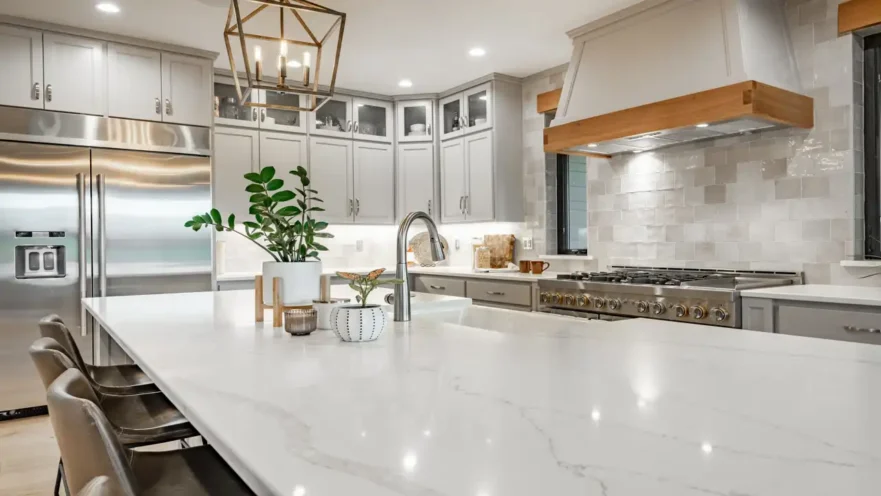Backsplashes Explained
Backsplashes are an essential design and functional element in modern kitchens and bathrooms. They not only enhance the visual appeal of these spaces but also serve a practical purpose by protecting walls from water, grease, and stains. For property investors managing residential real estate, choosing the right backsplash can add value to an investment property, attract tenants, and simplify maintenance.
If you’re a property investor looking to maximize your ROI, this comprehensive guide will cover everything you need to know about backsplashes. From understanding the available material options to their costs and installation process, this guide focuses on helping you make informed decisions that align with your investment strategies.
What is a Backsplash?
A backsplash is a vertical covering installed on the wall behind sinks, stoves, or countertops in kitchens and bathrooms. Its primary function is to shield the wall from spills, splashes, and grime, ensuring that the overall space stays looking fresh and clean. However, a backsplash is not just functional; it’s also a significant decorative element that can make or break the overall aesthetic of a room.
For real estate investors, a backsplash adds that extra layer of appeal that tenants love, making your property stand out in competitive rental markets.
Types of Backsplashes
When selecting a backsplash for your investment property, you’ll encounter a variety of materials, each with unique pros, cons, and costs. Here’s a detailed breakdown of the most popular options.
Tile Backsplash
Tile backsplashes are the most common and versatile choice for kitchens and bathrooms.
Features:
- Available in ceramic, porcelain, or natural stone tiles.
- Comes in a wide range of colors, shapes, and patterns.
Pros:
- Durable and easy to clean.
- Heat and water-resistant, making it ideal for stoves and sinks.
Cons:
- Grout can discolor over time and may require upkeep.
Glass Backsplash
Glass backsplashes are sleek, modern, and reflective, which can make small spaces feel larger.
Features:
- Can be made from large glass panels or smaller glass tiles.
- Offers customizable colors and designs.
Pros:
- Stain-resistant and exceptionally easy to clean.
- Adds a luxurious and contemporary look.
Cons:
- Higher material and installation cost compared to tiles.
Stone Backsplash
Stone backsplashes, such as marble or granite, make a bold and elegant statement.
Features:
- Typically used for luxurious properties.
- Unique patterns and textures enhance the aesthetic appeal.
Pros:
- Adds a high-end, opulent feel to the property.
- Extremely durable when sealed properly.
Cons:
- Requires more maintenance to prevent staining and wear.
- Expensive to source and install.
Metal Backsplash
Metal backsplashes are minimalist and highly functional.
Features:
- Usually made from stainless steel, copper, or aluminum.
- Often seen in chef-inspired kitchens.
Pros:
- Heat-resistant and easy to clean.
- Durable and long-lasting.
Cons:
- Can dent or scratch easily.
- Limited design versatility compared to tiles or glass.
Other Materials
Less conventional materials like wood, concrete, or peel-and-stick panels are also available, offering diverse options for creative designs.
Features:
- Best for budget-conscious or DIY renovations.
- More temporary and customizable solutions.
Pros:
- Affordable and quick to install.
- Offers unique and trendy aesthetics.
Cons:
- Often lacks the durability of more traditional materials.
- Not always ideal for water-heavy areas.
Cost per Square Foot
The cost of a backsplash hinges on two major factors—material and installation. Here’s what to expect in terms of average costs per square foot.
Material Costs
- Tile (Ceramic or Porcelain): $5–$35/sq. ft.
- Glass: $15–$30/sq. ft.
- Stone (Marble or Granite): $20–$50/sq. ft.
- Metal (Stainless Steel): $20–$50/sq. ft.
- Peel-and-Stick Panels (Budget-friendly): $5–$15/sq. ft.
Regional Variations
- Major Metro Areas (e.g., NYC, San Francisco): Prices can rise by 20–30% due to higher labor costs.
- Rural Areas: Material shipping costs could be higher, but labor costs tend to be lower.
- Phoenix Metro Area (Example): Tile prices average $10–$20/sq. ft., and stone options typically start around $25/sq. ft.
Installation Costs
Backsplash installation costs depend on labor prices, the complexity of the project, and the condition of the surface being worked on.
DIY vs Professional Installation
- DIY Installation:
- Cost for tools and materials only (~$100–$300 depending on the project size).
- Suitable for peel-and-stick options or pre-set tile sheets.
- Professional Installation:
- Labor generally ranges from $40–$100 per hour.
- Total installation averages $400–$1,200 for a standard 30-square-foot backsplash.
Factors Affecting Installation Cost
- Surface Preparation: Walls that require extensive priming or repairs will add to the cost.
- Complex Patterns (E.g., herringbone or mosaic styles): These take more time and precision, increasing labor charges.
- Region (Metro vs Rural): Installing a backsplash in rural areas can be cheaper due to lower labor costs.
Benefits of Backsplashes in Investment Properties
Adding a backsplash to your property isn’t just a decorative choice. Here’s why it’s a must-have feature for investment properties.
Protection
A backsplash reduces damage caused by water, grease, and spills, keeping your kitchen and bathrooms in top condition. For landlords, this means fewer maintenance calls and lower long-term repair expenses.
Aesthetics
Today’s tenants value well-designed spaces. A stylish backsplash elevates the look of any kitchen or bathroom, making your property more attractive to potential renters.
Value
A well-installed backsplash is a small investment that offers significant returns. Properties with modern features tend to retain higher rental values and market appeal over time.
Work Cited
- “2023 Home Renovation Cost Guide.” HomeAdvisor. homeadvisor.com
- “Best Types of Kitchen Backsplashes.” Bob Vila. bobvila.com
- “Metro Area Renovation Pricing.” Remodeling Magazine. remodeling.hw.net

